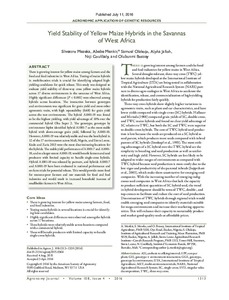| dc.contributor.author | Meseka, S.K. |
| dc.contributor.author | Menkir, A. |
| dc.contributor.author | Olakojo, S. |
| dc.contributor.author | Jalloh, A. |
| dc.contributor.author | Coulibaly, N. |
| dc.contributor.author | Bossey, O. |
| dc.date.accessioned | 2019-12-04T11:03:50Z |
| dc.date.available | 2019-12-04T11:03:50Z |
| dc.date.issued | 2016-07-11 |
| dc.identifier.citation | Meseka, S.K., Menkir, A., Olakojo, S., Coulibaly, N. & Bossey, O. (2016). Yield stability of yellow maize hybrids in the Savannas of west Africa. Agronomy Journal, 108, 1313-1320. |
| dc.identifier.issn | 0002-1962 |
| dc.identifier.uri | https://hdl.handle.net/20.500.12478/1250 |
| dc.description.abstract | There is growing interest for yellow maize among farmers and the food and feed industries in West Africa. Testing of maize hybrids in multi-location trials is crucial for identifying adapted high-yielding candidates for quick release. This study was designed to evaluate yield stability of three-way cross yellow maize hybrids across 17 diverse environments in the savannas of West Africa. Highly significant differences (P < 0.001) were observed among hybrids across locations. The interaction between genotypes and environments was significant for grain yield and most other agronomic traits, with high repeatability (0.68) for grain yield across the test environments. The hybrid A1001-19 was found to be the highest yielding, with yield advantage of 10% over the commercial hybrid Oba Super 2. The genotype, genotype by environment biplot identified hybrid A1001-7 as the most stable hybrid with above-average grain yield, followed by A1001-10. However, A1001-19 was relatively stable and was the best hybrid in 12 of the 17 environments across Mali, Nigeria, and Sierra Leone. Kudu and Zaria 2013 were the most discriminating locations for the hybrids. The stable yield performance of A1001-7 and A1001-10, and to a larger extent A1001-19, would benefit farmers and seed producers with limited capacity to handle single-cross hybrids. Hybrid A1001-10 was released by partners, and hybrids A1001-7 and A1001-19 have been evaluated in national performance and on-farm trials for potential release. This would provide more food for resource-poor farmers and raw materials for food and feed industries and would result in increased household incomes of smallholder farmers in West Africa. |
| dc.format.extent | 1313-1320 |
| dc.language.iso | en |
| dc.subject | Stability |
| dc.subject | Drought Tolerance |
| dc.subject | Maize |
| dc.title | Yield stability of yellow maize hybrids in the Savannas of west Africa |
| dc.type | Journal Article |
| dc.description.version | Peer Review |
| cg.contributor.crp | Maize |
| cg.contributor.affiliation | International Institute of Tropical Agriculture |
| cg.contributor.affiliation | Institute of Agricultural Research and Training, Nigeria |
| cg.contributor.affiliation | Sierra Leone Agricultural Research Institute |
| cg.contributor.affiliation | Institut d'Economie Rurale, Mali |
| cg.coverage.region | Africa |
| cg.coverage.region | West Africa |
| cg.coverage.country | Mali |
| cg.coverage.country | Nigeria |
| cg.coverage.country | Sierra Leone |
| cg.isijournal | ISI Journal |
| cg.authorship.types | CGIAR and developing country institute |
| cg.iitasubject | Genetic Improvement |
| cg.iitasubject | Maize |
| cg.journal | Agronomy Journal |
| cg.howpublished | Formally Published |
| cg.accessibilitystatus | Limited Access |
| local.dspaceid | 78524 |
| cg.targetaudience | Scientists |
| cg.identifier.doi | https://dx.doi.org/10.2134/agronj2015.0366 |

